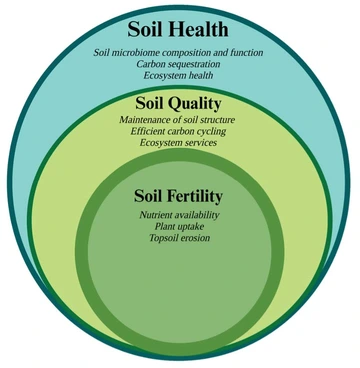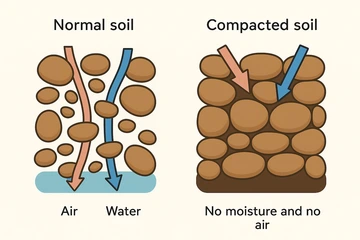Healthy soils are key to healthy agroecosystems. Just as human health indicates a holistic condition of the human body and cannot be defined or measured using a single parameter, soil health also does not have a singular definition or measurement. The United States Department of Agriculture (USDA) defines soil health as the continued capacity of soil to function as a vital living ecosystem that sustains plants, animals, and humans. Some scientists define soil health highlighting the agricultural services of soil, such as the production of food and fiber1 and the specific agronomic practices that can improve soil health.

Figure 1. Conceptualizing soil health, soil quality in relation to soil fertility.
Soil quality is a term, previously used to refer to the physical and chemical attributes of soil, including structure, color, cation exchange capacity, nutrient contents, and soil organic matter.2 Although similar, soil quality and soil health are two different concepts. Soil quality focuses only on the physical and chemical properties, the relatively less-dynamic properties (Figure 1). Soil health considers not only the physical and chemical properties but also the dynamic, biological components of a complex functional soil system. Adding the living world to the equation is crucial because the ‘life’ that resides within the soil is responsible for many ecosystem functions (Figure 1). Through this article, we would like to share modern soil health concepts with agricultural practitioners and educators.
Like soil, the human body thrives when all its intricate components work harmoniously together. To measure human health, one needs to measure physical, chemical, and structural characteristics like temperature, blood composition, and bone density as well as the living microbiome that protects and ensures gut health. Soil encompasses a complex web of interdependent factors; therefore, assessing soil health requires measuring various physical, chemical, and biological properties. Equating soil health to human health can help us better understand its multi-faceted nature and allow us to appreciate its significance in sustainable agriculture.
The structural framework
Soil health relies on a well-structured foundation, similar to the human skeletal structure. Soil structure refers to how soil particles – sand, silt, clay – bind together, forming aggregates of different dimensions and sizes, developing pore spaces like large macropores and small micropores. Pore spaces allow for water and air circulation and retention, root proliferation, and provide space for soil-dwelling organisms. Healthy soil structures are less compacted, and protected from erosion and waterlogging, enabling roots to access nutrients and support beneficial organisms. Soil water, acting as the ‘blood’ of soil-plant systems, regulates the translocation of nutrients, and helps plants access essential nutrition.3 Impediments of soil water movement like soil compaction or high salt concentration cause nutritional deficiencies in plants (Figure 2).

Figure 2. Compaction impedes air and water movement in soils, which negatively impacts soil biological communities and plant physiological activities such as nutrition and root respiration (graphic adapted from Paul Baker).
Along with water, aeration is also necessary as roots and biological communities essential in healthy soil require oxygen for respiration. Therefore, air and water maintain the ‘flow of life’ in a healthy soil system.
The biological symphony
Soil shelters diverse biological communities that participate in the cycling of carbon, nitrogen, phosphorus, sulfur, and other essential elements, while providing environmental services such as carbon sequestration and reduced greenhouse gas emissions. Carbon and nutrient cycling are predominantly dependent on microorganisms. Healthy soil, much like the human gut microbiome, typically hosts a diverse array of beneficial organisms – including bacteria, fungi, protozoa, actinomycetes, and arthropods. These biological communities work alone or in partnerships to participate in complex soil processes that improve nutrient availability, enhance soil structure, and increase plant resilience to biotic and abiotic stressors. Without biological communities in the soil, nutrient cycling will slow, and eventually, the soil will lose its fertility and potential to produce healthy, high-yielding crops. Sometimes we consume ‘probiotics’ to maintain a healthy gut; similarly, ‘amendments’ such as manure, compost, and microbial inoculations may be needed to boost soil health.
Balanced nutrition
Soil health is dependent on efficient nutrient management similar to a ‘balanced diet’. Routine comprehensive soil testing and soil health assessments are necessary to plan for effective nutrient management. Healthier soils can support crops even under adverse environmental conditions. An imbalanced diet can cause health issues; similarly, in soil, nutrient imbalances can have detrimental effects on soil health. These imbalances negatively affect soil biology, nutrient cycling, and ultimately, plant health.
Healthy soils and plants are the result of a SMART nutrient management system: right Source, right Method, right Assessment, right Rate, and right Timing of application (Figure 3). Every soil and each crop is different. Much like individual humans have specific dietary needs, each soil requires a tailored nutrient management protocol to support a specific crop with balanced nutrition, addressing both the type and amount of nutrients needed. Healthy soils, therefore, should be maintained by supplementing nutrient needs following the SMART protocol.

Figure 3. SMART nutrient management is essential for healthy and productive soils that feed the crop plants optimally (USDA, 2022).
Soil function is multifaceted: regulating the movement of water and gases, sustaining life, filtering and buffering contaminants and environmental pollutants, and cycling nutrients. Considering the dynamic nature of soil systems, soil health should be simply defined as the capacity of the soil to function effectively.
Holistic management
Managing healthy soils and maintaining a healthy human body both rely on a holistic approach. Healthy humans must maintain optimal health parameters, including platelet counts, blood glucose levels, and a balanced gut microbiome. Unless soil properties like pH, salt contents, nutrient availability, organic matter levels, soil microbiome and are at an optimum state, the soil cannot function optimally. For example, a soil with high organic carbon content will not be considered healthy if the pH level is too low, such as below pH 5, or lacks the ideal amount of essential nutrients like nitrogen or sulfur. In essence, soil health management involves effectively managing soil properties to ensure the soil is functioning at a level to support healthy plant growth.
References
- Kibblewhite, M. G., Ritz, K., & Swift, M. J. (2008). Philosophical Transactions of the Royal Society B: Biological Sciences, 363(1492), 685-701.
- Curell, C., Gross, P., & Steinke, K. (2012). https://www.canr.msu.edu/news/soil_health_and_soil_quality
- Brady, N. C., Weil, R. R., & Weil, R. R. (2008). The nature and properties of soils (Vol. 13, pp. 662-710). Upper Saddle River, NJ: Prentice Hall.
- United States Department of Agriculture. (2022). Factsheet: SMART Nutrient Management Save Money and Protect Water Quality. https://www.farmers.gov/sites/default/files/2022-09/farmersgov-fact-she…

